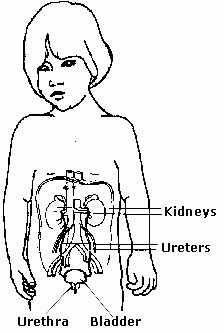An intravenous urogram (IVU) is a test that shows us how your kidneys work. The kidneys are a pair of bean-shaped organs that allow the body to collect urine and send it to the bladder. The test is done in the Radiology Department. During this test we will take X-ray pictures of your child's kidneys.
If you have any questions about this test, please contact the Radiology Department.
Preparing your child for the IVU
Children 0 to 2 years
- On the day of the test: Give no solid foods until after the test is finished. Children may have juice or water on the morning of the test, up until three hours before the test begins.
Children 2 to 15 years
- The evening before the test: Give your child a Dulcolax suppository. Repeat this dose in the morning. If the second Dulcolax dose does not result in a very large bowel movement, give your child a saline or Fleet's enema. You can buy this at your local pharmacy.
- On the day of the test: Give no solid foods until after the test is finished. Children may have juice or water on the morning of the test, up until three hours before the test begins.
What happens on the day of the test?
On the day of the test, you will meet a radiologic technologist (RT). The RT helps the doctor, takes X-ray pictures, and answers your questions.
After your child has gone to the bathroom to empty his or her bladder, the RT will bring your child into an X-ray room. The room has a table with a square machine above it. This machine is like a large camera. It takes X-ray pictures that show how your child's kidneys are working. We will ask your child to lie very still, so that the X-ray pictures will be clear.
The RT will take an X-ray of your child's abdomen. The RT or doctor will inject some contrast material into a vein in your child's arm through an IV. When the needle goes into your child's arm it stings for a moment.
Contrast material is a liquid that goes from your child's vein into the kidneys. This allows the kidneys to be seen clearly on a x-ray. We will take some pictures of your child's kidneys as the contrast material goes from the kidneys to the bladder. The bladder is a balloon shaped organ where urine is stored in between the times your child goes to the bathroom.
You or your child may ask the RT any questions about what is happening. We will develop all of the X-ray pictures before you leave to be sure they are what the doctor needs.
Page reviewed on: Jan 24, 2005
